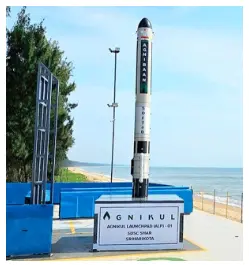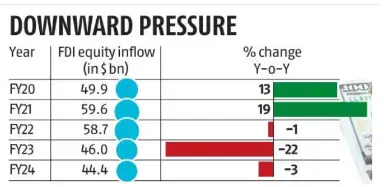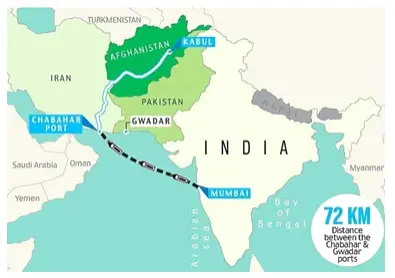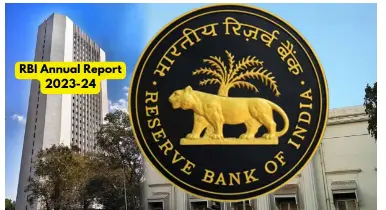Monday, 3rd June 2024
India's First 3D-Printed Rocket Launched
In News
- Recently, Chennai-headquartered space start-up Agnikul Cosmos Private Limited launched the world’s first rocket “Agnibaan SubOrbital Technology Demonstrator (SOrTeD)” with a single piece 3D-printed engine from Sriharikota .

About the Agnibaan SOrTeD :
- Its objective is to conduct a test flight to demonstrate the company's proprietary technologies and collect vital flight data.
- Agnibaan is a customizable, two-stage launch vehicle that can carry a payload of up to 300 kg into orbit of about 700 km.
- This accomplishment marks several milestones for the Indian space sector, including the first launch from a private pad (Dhanush), the maiden flight of a domestically developed semi-cryo engine-powered rocket.
- The rocket utilises liquid oxygen and kerosene as propellants and received support from the Indian Space Research Organisation (ISRO) and the Indian National Space Promotion and Authorisation Centre (IN-SPACe).
- 3D printing, also known as additive manufacturing, involves the use of materials like plastics and metals to transform computer-aided design concepts into tangible three-dimensional objects.
- This method contrasts with subtractive manufacturing, which entails cutting or hollowing out metal or plastic using tools like milling machines.
Decline in FDI Equity Inflows in FY 2024
In the News:
- Foreign direct equity investments fell to a five-year low of $44.42 billion in FY24 due to high interest rates in advanced economies and limited absorptive capacity in various Indian sectors.
Key Highlights of decline in FDI:
- The Foreign direct investment (FDI) equity inflows in India reached a five-year low of USD 44.42 billion in the financial year ended 31st March 2024 (FY24), marking a 3.5% year-on-year (Y-o-Y) contraction.
- The decrease in FDI equity inflows can be attributed to external factors such as high interest rates in advanced economies and limited absorptive capacity in various sectors in India.
- Total FDI, encompassing equity capital, reinvested earnings, and other capital, contracted by 1% Y-o-Y to USD 70.95 billion during FY24 as per the Department for Promotion of Industry and Internal Trade (DPIIT).
- Singapore retained its position as the top investor with USD 11.77 billion in FDI, followed by Mauritius, the United States, Netherlands, and Japan.
- Maharashtra remained the most favoured destination for investors, attracting USD 15.11 billion worth of investments, although inflows declined by 2%, followed by Karnataka.
- Computer software and hardware, services sector, and trading were the leading recipients of FDI, but all three sectors witnessed a decline in inflows.

Ahilya Bai Holkar
In the News:
- The 300th birth anniversary of the Maratha queen Ahilya Bai Holkar was celebrated.
About the Ahilya Bai Holkar:
- She was the queen of Indore within the Maratha Confederacy. She established Maheshwar (in Madhya Pradesh) on the banks of the Narmada River as the capital of the Holkar Dynasty.
- She was born in 1725 to a Dhangar/Gadariya (shepherd) family in Maharashtra’s Ahmednagar district.
- Her father, Mankoji Shinde, was from a respectable Dhangar (Gadariya) family who served as the Patil (title like village head).
- Although women did not go to school back then, Ahilyabai’s father taught her to read and write.
- She married Khande Rao Holkar, son of Malhar Rao Holkar, an army commander to Peshwa Bajirao.
|
Battle of Kumbher (1754)
|
- Malhar Rao Holkar died in 1766, 12 years after the death of his son Khande Rao. Then Khande Rao’s only son, Male Rao Holkar, became the ruler of Indore in 1766, under Ahilyabai’s regency.
- Male Rao Holkar, too, died in April 1767. Then Ahilyabai took over as ruler of Malwa with Tukoji Rao Holkar (Malhar Rao’s adopted son and a soldier in his army ) as her military head.
- She worked to preserve and encourage India’s spiritual integrity and displayed administrative ingenuity and political impartiality.
Contributions
Renovation of temples:
- Ahilya Bai resurrected the jyotirlingas across the country as a tribute to Lord Shiva.
- She carried out renovations in Somnath temple, Kashi Vishwanath temple Varanasi (1780), Trambak, Gaya, Pushkar, Vrindavan, Nathdwara, Haridwar, Badrinath, Kedarnath and many other sacred sites.
Other contributions:
- She patronised many artists, including Marathi poet Moropant, Shahir Ananta Gandhi, and Sanskrit scholar Khushali Ram.
- She promoted Maheshwari saris (from Maheshwar) and paved the way for empowering women.
- Ahilyabai repealed a traditional law that allowed the state to confiscate the property of childless widows.
- She made efforts to develop the city of Indore, conserve forests and animals, and was responsible for the flourishing trade and commerce.
Legacy:
- She was described as “a very able ruler and organiser” by Jawaharlal Nehru in ‘A Discovery of India’.
- A proposal to rename Ahmednagar as ‘Punyashlok Ahilyadevi Nagar’ is being discussed.
Conclusion:
Hence, Ahilya Bai Holkar's governance stands as a testament to inclusive policy making and effective leadership. Her remarkable legacy serves as a blueprint for modern governance, advocating for a society free from gender norms and biases, and striving towards the ideals of Ram Rajya.
Source: (IE)
India Questioned at the WTO For Its Rice Export Policy
In the News:
- Recently, Canada, Brazil, Australia, and the UK queried India's rice export policy at the WTO, seeking clarity on whether India barred its rice exporters from UN World Food Program tenders this year for broken rice supplies to nations like Cameroon, Togo, and Algeria.
UN World Food Programme:
- The United Nations World Food Programme (WFP) is the largest humanitarian organisation dedicated to addressing hunger and food security worldwide.
- Since its establishment in 1961, it has provided food assistance during emergencies and collaborated with communities to enhance nutrition and resilience.
- With a mission to eradicate hunger and malnutrition globally, WFP depends on donations from governments, corporations, and individuals to support its initiatives.
India's Rise in Rice Exports:
- India holds the title of the largest rice exporter globally, commanding a significant 45% share in the world rice market.
- To stabilise domestic rice prices, India implemented a 20% export duty on white rice in September 2022, followed by a similar duty on parboiled rice in August 2023.
- The imposition of export duties aims to regulate rice prices domestically and address concerns regarding declining water tables, prompting the need to reduce paddy cultivation.
- A balanced approach is essential to safeguard the interests of both consumers and farmers while ensuring the conservation of water resources.
- Notably, the ban on rice exports primarily affects non-basmati rice, while basmati rice, constituting nearly half of India's exports, remains unaffected.
- Despite the export ban, India continues to supply rice to countries in need and its strategic partners, albeit on a case-by-case basis.
World Food Programme’s Rice Tenders:
- Many African nations heavily rely on rice imports from India, with Togo importing 88%, Benin procuring 61%, and Senegal obtaining nearly half of its rice imports from India.
- In August 2024, the WFP requested 200,000 tonnes of rice from India for its humanitarian efforts due to severe global food insecurity exacerbated by the COVID-19 pandemic and the Ukraine war.
- However, in February 2024, the Indian Government prohibited domestic rice exporters from participating in tenders issued by the United Nations World Food Programme.
Countries Seek Clarification on India's Rice Export Ban:
- During a WTO agriculture committee meeting, the UK highlighted India's restrictions on rice exports, leading to a significant decline in total rice exports in 2023-24.
- Concerns were raised that if India indeed halted participation in WFP exports, it would breach its commitment to exempt such supplies from export restrictions, as agreed upon during the WTO's 12th Ministerial Conference.
- Initially, India had reservations about this decision, citing concerns about maintaining flexibility in imposing export restrictions for domestic food security but eventually consented.
- At the recent WTO meeting, Australia, Canada, Brazil, Switzerland, and the UK sought clarification from India on the issue, to which India did not provide immediate answers.
|
UPSC Civil Services Examination Previous Year Question (PYQ) Prelims Q 1. Among the following, which one is the largest exporter of rice in the world in the last five years? (2019) (a) China (b) India (c) Myanmar (d) Vietnam Ans: (b) Q 2. According to India’s National Policy on Biofuels, which of the following can be used as raw materials for the production of biofuels? (2020)
Select the correct answer using the code given below: (a) 1, 2, 5 and 6 only (b) 1, 3, 4 and 6 only (c) 2, 3, 4 and 5 only (d) 1, 2, 3, 4, 5 and 6 Ans: (a) |
Source: (TH)
India GDP growth -Surge
In the News:
- Recently, the Indian economy outpaced expectations, expanding by 7.8% year-on-year in the January-March (2024) quarter, propelled by strong performance in the manufacturing sector.
- For the entire fiscal year 2023-24 (FY24), India's Real GDP is projected to have surged by a robust 8.2%, indicating sustained growth momentum.
Key Takeaways from India’s Q4 GDP:
India Emerges as Fastest-Growing Major Economy:
- The Indian government has revised its economic growth forecast for the 2023/24 fiscal year to 8.2%, surpassing the earlier estimate of 7.6% by the National Statistical Office (NSO). This growth momentum persists despite challenges in the agricultural sector.
- While real GDP still lags approximately 7.5% behind its pre-pandemic levels, the Indian economy demonstrates resilience and potential for robust growth, propelled by domestic strengths and strategic policy interventions.
GDP Growth and Projections:
- Real GDP is forecasted to reach Rs 173.82 lakh crore in FY24, a significant increase from Rs 160.71 lakh crore in FY23.
- Similarly, nominal GDP is expected to grow by 9.6% to ₹295.36 lakh crore in FY24 from ₹269.50 lakh crore in FY23.
Growth rate in GVA terms:
- Gross Value Added (GVA) growth stood at 6.3% in the January-March (2024) quarter, up from 6.8% in the previous quarter and 6% in Q4 FY23. For the full fiscal year FY24, GVA growth was recorded at 7.2%, compared to 6.7% in FY23.
- The divergence between GVA and GDP growth rates is notable, attributed to a significant increase in net taxes, indicating higher tax collections and reduced subsidies in the last quarter.
Performance of the different sectors:
- Manufacturing Sector: Experienced a remarkable acceleration in Gross Value Added (GVA) growth, reaching 8.9% in the March quarter, a substantial improvement from the 0.9% growth recorded in the same period of the previous year.
- Mining Sector: Witnessed an uptick in GVA growth, rising to 4.3% in the fourth quarter from 2.9% in the corresponding quarter of the previous fiscal year.
- Construction Sector: Demonstrated robust growth, expanding by 8.7% in the quarter, surpassing the 7.4% growth observed in the same period of the previous fiscal year.
- Agriculture Sector: Experienced a deceleration in growth, slowing down to 0.6% from 7.6% in the previous year, indicating challenges and disruptions faced by the sector.
- Services Sector: GVA growth in trade, hotel, transport, communication, and related services moderated to 5.1% in the fourth quarter, compared to a growth of 7% a year ago, reflecting a slowdown in certain service-related activities
Fiscal Deficit and Investment:
- The Central government's fiscal deficit during 2023-24 stood at 5.6% of the GDP, better than previous estimates of 5.8%, attributed to higher revenue realisation and lower expenditure. In absolute terms, the fiscal deficit amounted to ₹16.53 lakh crore.
- According to the FRBM Act, the government aims to achieve a fiscal deficit of 4.5% in 2025-26, reflecting its commitment to fiscal discipline and prudent financial management.
Investment and Expenditure Growth:
- Despite sluggish growth in Private Final Consumption Expenditure (PFCE) at 4.0%, the primary demand-side impetus is coming from Gross Fixed Capital Formation (GFCF), which has grown by 9.0%, indicating a positive trend in investment and capital expenditure
|
UPSC Civil Services Examination, Previous Year Questions (PYQs) Prelims Q1. With reference to Indian economy, consider the following statements: (2015)
Which of the statements given above is/are correct? (a) 1 only (b) 2 only (c) Both 1 and 2 (d) Neither 1 nor 2 Ans: (b) Q2. A decrease in tax to GDP ratio of a country indicates which of the following? (2015)
Select the correct answer using the code given below: (a) 1 only (b) 2 only (c) Both 1 and 2 (d) Neither 1 nor 2 Ans: (a) Mains Q1. Define potential GDP and explain its determinants. What are the factors that have been inhibiting India from realising its potential GDP? (2020) Q2. Explain the difference between computing methodology of India’s Gross Domestic Product (GDP) before the year 2015 and after the year 2015. (2021) |
Source: (TH)
Conservation planning for Gangetic dolphin.
In the News:
- A recent study was conducted by scientists by surveying the tributaries and sub-tributaries of the Ganga river and focused on the rescue and relocation of Gangetic river dolphins from precarious situations within the irrigation canals of the Ganga-Ghagra basin.
- The Ganga River Dolphin (Platanista gangetica), also known as the “Tiger of the Ganges” was officially discovered in 1801.

Key Highlights of the study:
- Small rivers are vital habitats for the Gangetic dolphins, hosting over 15% of their population.
- The distribution of these dolphins has declined in several rivers including Son, Ken, Betwa, Sind, Sharda, and the upper stretch of the Yamuna River.
- More than 70% of dolphin entrapments occurred after the monsoon season or during peak winter, with the remaining 30% rescued during peak summer when water levels decrease and minimum flow is maintained.
- Specifically, between 2013 and 2020, 19 Gangetic river dolphins were rescued from irrigation canals in the Ganga-Ghagra basin in Uttar Pradesh.
Features:
- The Ganges river dolphin, adapted solely to freshwater environments, relies heavily on echolocation due to its poor eyesight. Emitting ultrasonic sounds, it navigates and hunts, forming mental images based on the returning sound waves.
- Typically solitary or in small groups, they often travel in pairs consisting of a mother and calf.
- With females larger than males, the species reproduces slowly, with females giving birth to a single calf once every two to three years.
- As mammals, Ganges river dolphins require air to breathe and must resurface regularly, typically every 30 to 120 seconds.
- Due to the distinctive sound it makes when surfacing for air, locals affectionately refer to the creature as 'Susu'.
Primary Threats:
- Accidental entanglement in fishing gear poses a significant risk to Ganges river dolphins.
- Poaching remains a threat, driven by the demand for dolphin oil used in fishing and traditional medicine.
- Habitat destruction due to various human activities such as water extraction, construction of dams and embankments, and pollution from industrial waste and sewage discharge.
- Conservation Statu
Protection Status:
- Endangered according to the International Union for Conservation of Nature (IUCN).
- Listed under Schedule I of the Indian Wildlife (Protection) Act, 1972.
- Classified under Appendix I of the Convention on International Trade in Endangered Species (CITES)
- Appendix I of the Convention on Migratory Species (CMS).
Government Initiatives:
- Project Dolphin aims to conserve and protect the Ganges river dolphin population.
- Establishment of the Vikramshila Ganges Dolphin Sanctuary in Bihar to safeguard their habitat.
- Observance of National Ganga River Dolphin Day on October 5th to raise awareness and promote conservation efforts.
|
UPSC Civil Services Examination, Previous Year Question Q:1 Which one of the following is the national aquatic animal of India? (2015) (a) Saltwater crocodile (b) Olive ridley turtle (c) Gangetic dolphin (d) Gharial Ans: (c) |
Source: Scroll
Chabahar port
Context:
- Recently India signed a 10-year agreement with Iran to develop and manage the Chabahar port, marking a pivotal development in bilateral ties between the two nations. This agreement comes at a tumultuous time in West Asia, marked by ongoing conflict in Gaza, heightened Israel-Iran tensions.
Chabahar Project:
- In May 2016, India signed a tripartite agreement with Iran and Afghanistan to develop the Shahid Beheshti Terminal at Chabahar. This marks India's first foreign port project.
- The agreement aims to establish an international transport and transit corridor in Chabahar.
- The major highlights of this project include the construction of the Chabahar Port and a rail line from Chabahar Port to Zahedan.
- The port is intended to enable India to bypass Pakistan and access Afghanistan and Central Asia.
- Additionally, the port could serve as a hub for transit trade between India, Iran, and Afghanistan, providing an alternative route to the traditional Silk Road that passes through China.

Chabahar Port Important for India:
- Alternative Trade Route: Offering an alternative to transit routes through Pakistan, Chabahar Port reduces India's dependence on its neighbour for trade with Afghanistan and beyond. It facilitates access to Iran, a crucial gateway to the International North-South Transport Corridor (INSTC), enhancing connectivity with Russia, Central Asia, and Europe.
- Economic Benefits: Chabahar facilitates India's efforts to strengthen connections with resource-rich Central Asian countries and Afghanistan. It diversifies trading routes, providing access to markets beyond Iran and Afghanistan, including Russia, Eurasia, and Europe. Cargo movement via the INSTC route is cost-effective, saving 30% in costs and 40% in transportation time.
- Humanitarian Assistance: The port serves as a vital entry point for humanitarian aid and reconstruction efforts in Afghanistan. It has played a significant role in supplying aid during crises, such as the Covid-19 pandemic, with India trans-shipping wheat, pulses, and pesticides to Afghanistan via Chabahar.
- Counterbalancing China's String of Pearls Strategy: Chabahar serves as a crucial component of India's Necklace of Diamond Strategy, allowing India to monitor and potentially disrupt China's strategic encirclement in the Indian Ocean region. By establishing a presence in Chabahar, India can counterbalance China's strategic facilities in locations like Gwadar (Pakistan) and Hambantota (Sri Lanka).
- Diplomatic Engagement and Multilateralism: India's collaboration with Iran, Afghanistan, and Central Asian nations in the Chabahar project underscores its commitment to diplomacy and multilateralism. The port aligns with international efforts to enhance connectivity across Eurasia, positioning India as a key player in regional development initiatives.
- Energy Security: Chabahar Port offers a strategic gateway for importing Iranian oil and gas, diversifying India's energy sources. This diversification strengthens India's energy security, ensuring a stable and resilient energy supply for its growing economy.
The Major Challenges India Faces with the Chabahar Port Project:
- Impact of New U.S. Sanctions: Recent U.S. sanctions on Iran, triggered by drone strikes on Israel, exacerbate the risk of companies avoiding involvement in Chabahar, potentially hindering project progress and investment.
- Internal Political Instability in Iran: Iran's political volatility and internal conflicts threaten project continuity, creating uncertainties that could disrupt infrastructure development at Chabahar.
- Regional Instability and Conflicts: Ongoing conflicts in the region, such as Israel's war in Gaza and disruptions to maritime trade by Iran-backed armed groups, contribute to regional instability, impacting the operational efficiency of Chabahar.
- Challenging Business Environment: Iran's low Ease of Doing Business ranking reflects its challenging business environment, presenting hurdles to the smooth execution and success of projects at Chabahar.
- Competition from China and Pakistan: Iran's openness to Chinese and Pakistani investment in Chabahar alongside India introduces competitive pressures, influencing India's strategic positioning and investment decisions.
- Divergent Regional Priorities: India's involvement in Chabahar may strain its relations with key regional players like Saudi Arabia and Israel, who perceive Iran as a destabilising force, necessitating diplomatic efforts to reconcile divergent priorities.
- Environmental Concerns: The delicate ecosystem of the Gulf of Oman, where Chabahar is located, faces risks of pollution from increased shipping traffic and potential oil spills, underscoring the importance of proactive environmental management in project planning and execution.
Measures can India Adopt to Curtail Issues Related to Chabahar:
- Multilateral Financing Mechanism: India could establish a multilateral financing mechanism involving like-minded countries such as Russia and European nations. This diversified investment pool would mitigate risks associated with unilateral sanctions and political pressures.
- Regionalize the Project: Instead of a strictly bilateral initiative, India could regionalize the Chabahar project by inviting participation from Central Asian nations. This approach would address concerns about Iran's influence and foster regional cooperation.
- Green Shipping Corridor: Positioning Chabahar as a pioneer in green shipping practices would attract international support and financing. By adopting environmentally sustainable measures, the port could mitigate ecological concerns and gain broader backing.
- Digital Silk Road: India could leverage Chabahar to establish a Digital Silk Road, promoting digital infrastructure and e-commerce along the INSTC route. This initiative would diversify stakeholders and reduce reliance on traditional players affected by geopolitical tensions.
- Soft Power Diplomacy: Complementing economic efforts with soft power diplomacy, India could foster cultural exchanges and educational partnerships with countries along the INSTC. These initiatives would build goodwill and mitigate geopolitical tensions affecting the Chabahar project
|
UPSC Civil Services Examination, Previous Year Question (PYQ) Prelims Q. What is the importance of developing Chabahar Port by India? (2017) (a) India’s trade with African countries will increase enormously. (b) India’s relations with oil-producing Arab countries will be strengthened. (c) India will not depend on Pakistan for access to Afghanistan and Central Asia. (d) Pakistan will facilitate and protect the installation of a gas pipeline between Iraq and India.
Ans: (c) Mains Q:1 In what ways would the ongoing U.S-Iran Nuclear Pact Controversy affect the national interest of India? How should India respond to this situation? (2018) Q:2 The question of India’s Energy Security constitutes the most important part of India’s economic progress. Analyse India’s energy policy cooperation with West Asian countries. (2017) |
Source: (HT)
Share the article
Edukemy’s Current Affairs Quiz is published with multiple choice questions for UPSC exams
MCQ
Get Latest Updates on Offers, Event dates, and free Mentorship sessions.

Get in touch with our Expert Academic Counsellors 👋
FAQs
UPSC Daily Current Affairs focuses on learning current events on a daily basis. An aspirant needs to study regular and updated information about current events, news, and relevant topics that are important for UPSC aspirants. It covers national and international affairs, government policies, socio-economic issues, science and technology advancements, and more.
UPSC Daily Current Affairs provides aspirants with a concise and comprehensive overview of the latest happenings and developments across various fields. It helps aspirants stay updated with current affairs and provides them with valuable insights and analysis, which are essential for answering questions in the UPSC examinations. It enhances their knowledge, analytical skills, and ability to connect current affairs with the UPSC syllabus.
UPSC Daily Current Affairs covers a wide range of topics, including politics, economics, science and technology, environment, social issues, governance, international relations, and more. It offers news summaries, in-depth analyses, editorials, opinion pieces, and relevant study materials. It also provides practice questions and quizzes to help aspirants test their understanding of current affairs.
Edukemy's UPSC Daily Current Affairs can be accessed through:
- UPSC Daily Current Affairs can be accessed through Current Affairs tab at the top of the Main Page of Edukemy.
- Edukemy Mobile app: The Daily Current Affairs can also be access through Edukemy Mobile App.
- Social media: Follow Edukemy’s official social media accounts or pages that provide UPSC Daily Current Affairs updates, including Facebook, Twitter, or Telegram channels.





